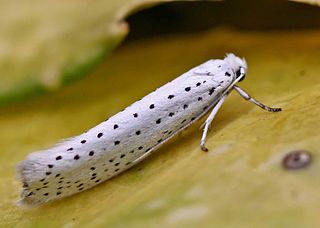
The family Yponomeutidae are known as the ermine moths, with several hundred species, most of them in the tropics. The larvae tend to form communal webs, and some are minor pests in agriculture, forestry, and horticulture. Adult moths are minor pollinators.

Ermine in heraldry is a "fur", a type of tincture, consisting of a white background with a pattern of black shapes representing the winter coat of the stoat. The linings of medieval coronation cloaks and some other garments, usually reserved for use by high-ranking peers and royalty, were made by sewing many ermine furs together to produce a luxurious white fur with patterns of hanging black-tipped tails. Due largely to the association of the ermine fur with the linings of coronation cloaks, crowns and peerage caps, the heraldic tincture of ermine was usually reserved to similar applications in heraldry. In heraldry it has become especially associated with the Duchy of Brittany and Breton heraldry.

The bird-cherry ermine is a species of moth in the family Yponomeutidae, the ermine moths. The wingspan of the moth ranges from 16 to 25 mm. The insect was first described in 1758 by the Swedish naturalist Carl Linnaeus who gave it the name Phalaena evonymella; it was later transferred to the genus Yponomeuta, becoming Yponomeuta evonymella. The moth can be found in the whole of Europe and the northern and eastern part of Asia.

Yponomeuta plumbella is a moth from the family Yponomeutidae, the ermine moths.
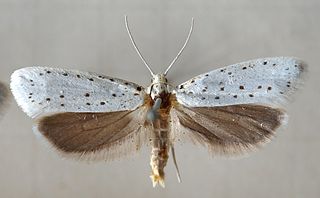
Yponomeuta cagnagella, the spindle ermine, is a moth from the family Yponomeutidae, the ermine moths. The wingspan of the moth ranges from 19 to 26 millimetres. The head is white. Forewings are white; four longitudinal series of few black dots, first not reaching middle, second beginning near before middle, lowest including 4-7 dots; some additional black dots before termen; cilia white. Hindwings are dark grey. The larva is pale greyish-yellowish; spots black; head black.
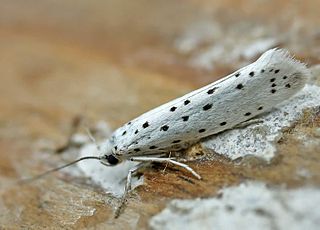
Yponomeuta padella is a lepidopteran from the family Yponomeutidae, the ermine moths. It is also known as the cherry ermine
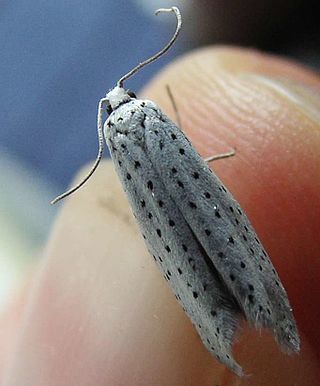
Yponomeutinae is a subfamily of "micromoths" in the lepidopteran family Yponomeutidae. As their scientific name implies, this is the subfamily containing the type genus of the ermine moths, Yponomeuta. The subfamily has worldwide distribution.

The chestnut ermine moth is an extinct species of moth in the subfamily Argyresthiinae. It was endemic to the United States. The species was only seen in two states, New Hampshire and Vermont. It became extinct due to chestnut blight obliterating its primary food source, the American chestnut.

Saint-Maudez is a commune in the Côtes-d'Armor department of Brittany in northwestern France. It is named after the Breton Saint Maudez.

Euonymus americanus is a species of flowering plant in the family Celastraceae. Common names include strawberry bush, American strawberry bush, bursting-heart, hearts-a-bustin, and hearts-bustin'-with-love. It is native to the eastern United States, its distribution extending as far west as Texas. It has also been recorded in Ontario.

Yponomeuta sedella is a moth of the family Yponomeutidae. It is found in Europe.

Yponomeuta malinellus, the apple ermine, is a moth of the family Yponomeutidae. It is native to Europe and Asia, and it has spread to North America.
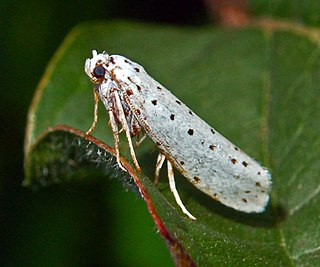
Yponomeuta is a large genus of moths of the family Yponomeutidae. It has 103 described member species.
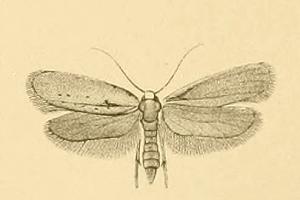
Yponomeuta gigas is a moth of the family Yponomeutidae. It is found on the Canary Islands.
Yponomeuta mahalebella is a moth of the family Yponomeutidae. It is found in France, Italy and Ukraine.

The American ermine or American stoat is a species of mustelid native to most of North America.
This page is based on this
Wikipedia article Text is available under the
CC BY-SA 4.0 license; additional terms may apply.
Images, videos and audio are available under their respective licenses.














